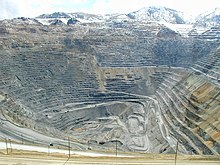Bingham Canyon mine

Mine in 2003
|
|
| Location | |
|---|---|
| Location | Salt Lake County |
| State | Utah |
| Country | United States |
| Coordinates | 40°31′23″N 112°09′04″W / 40.523°N 112.151°WCoordinates: 40°31′23″N 112°09′04″W / 40.523°N 112.151°W |
| Production | |
| Products | Copper |
| Type | Open-pit |
| History | |
| Opened | 1906 |
|
Bingham Canyon Open Pit Copper Mine
|
|
| Area | 900 hectares |
| NRHP Reference # | 66000736 |
| Significant dates | |
| Added to NRHP | November 13, 1966 |
| Designated NHL | November 13, 1966 |
The Bingham Canyon Mine, more commonly known as Kennecott Copper Mine among locals, is an open-pit mining operation extracting a large porphyry copper deposit southwest of Salt Lake City, Utah, USA, in the Oquirrh Mountains. The mine is the largest man-made excavation in the world. The mine is owned by Rio Tinto Group, an international mining and exploration company headquartered in the United Kingdom. The copper operations at Bingham Canyon Mine are managed through Kennecott Utah Copper Corporation which operates the mine, a concentrator plant, a smelter, and a refinery. The mine has been in production since 1906, and has resulted in the creation of a pit over 0.6 miles (970 m) deep, 2.5 miles (4 km) wide, and covering 1,900 acres (770 ha). It was designated a National Historic Landmark in 1966 under the name Bingham Canyon Open Pit Copper Mine. The mine experienced a massive landslide in April 2013 and a smaller slide in September 2013.
Minerals, in the form of copper ore, were first discovered in Bingham Canyon in 1848 by two brothers, Sanford and Thomas Bingham, sons of Erastus Bingham, Mormon pioneers of September 1847, who grazed their cattle there. They reported their find to their leader, Brigham Young, who advised against pursuing mining operations because the survival and establishment of settlements was of paramount importance at that time. The brothers applied themselves to that purpose as directed and did not stake a claim. In 1850, the Bingham family went to settle what is now Weber County, leaving the canyon still today known by their name.
It was not until 17 Sept. 1863 that extraction of ore began and the potential of the canyon's mineral resources began to be widely recognized. That was when George B. Ogilvie and 23 others "located the West Jordan claim", soon followed by the Vidette claim. At first, mining was confined to placer gold, lead-silver and copper-gold. Porphyry copper required processing and a railroad, which reached the canyon in 1873.
...
Wikipedia


